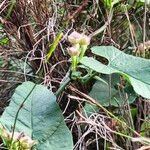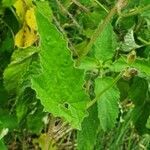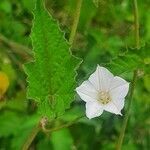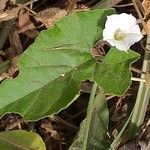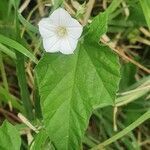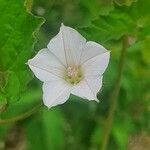Perennial; stems twining or prostrate, long-pubescent, velvety silky when young.. Leaf-blade triangular-ovate or ovate, rarely lanceolate, up to 6(–7.5) cm. long and 3.8(–4.5) cm. wide, obtuse, acute or apiculate at the apex, subsagittate or cordate at the base, ± shallowly crenate, shortly pubescent; petiole up to 4.5 cm. long.. Inflorescence 1–6-flowered; peduncle up to 4.5(–6) cm. long; pedicels up to 1.5 cm. long; bracts minute.. Sepals ovate-orbicular, ovate or elliptic, 6–7(–9) mm. long, 3–4.5 (–5) mm. wide, acute, ± coriaceous; outer often pubescent all over; inner pubescent in middle only, or all sepals only ciliate, often purplish at the tips.. Corolla white or tinged pinkish-purple, 11 (–16) mm. long, shortly lobed, pubescent at the tips.. Capsule 5–8 mm. in diameter, globose, pale brown.. Seeds globose, subtrigonous, black, 3.5–4 mm. long, 2.5 mm. wide.
Herbaceous perennial. Stems long, climbing or prostrate, pubescent, silvery when young. Leaves cordate-deltoid or sagittate, margins subentire to crenate, sinus broad, basal auricles 40-120 mm long, ± glabrous; petioles up to 65 mm long. Peduncles ± 65 mm long, 1-6-flowered; bracts minute; pedicels short. Sepals unequal, oblong to suborbicular, 6-8 mm long. Corolla funnel-shaped, white to pale pink, 12-15 mm long; midpetaline areas hairy. Flowering time all year. Fruit a subglobose capsule, 5-8 mm wide, pale brown. Seeds 4, ± 3-angled, 3.5-4.0 mm long, black, rough.
Leaf lamina triangular-ovate or ovate, rarely lanceolate, 3–11 × 3·8–6 cm., obtuse, acute or apiculate at the apex, subsagittate or cordate at the base, subentire to irregularly and shallowly crenate, herbaceous, drying membranous, glabrous above except when young, glabrous or more or less pubescent beneath and with distinct reticulate venation; basal sinus broad, basal auricles rounded or pointed, sometimes with a few teeth (very rarely leaves with additional triangular lobes above the basal auricles); petiole up to 6·5 cm. long.
Perennial herb. Stems procumbent or twining, pubescent or farinose-puberulous, younger shoots often silvery. Leaves with blade ovate to deltoid, 40-120 x 30-90 mm, base cordate, apex acute with mucro, margins shallowly and irregularly toothed. Flowers: subumbellately 1-6-flowered; calyx lobes oblong or elliptic to suborbicular, apices acute or obtuse with terminal mucro; corolla 12-14 mm long, lobes rounded to obtuse, white, very pale pink or pale pinkish mauve; Jan.-Dec. Fruit a subglobose, glabrous capsule, 5-8 mm in diameter.
A herb. It keeps growing from year to year. The stems are long and twining. The leaf blades are oval or triangle shaped. They are alternate. The leaf stalk is 7 cm long. The leaf blade is 3-11 cm long by 4-6 cm wide. The flowering stems are in the axils of leaves and stalks are 6 cm long. They are tube shaped and narrow. The fruit are round capsules 5-8 mm across. There are usually 4 seeds. They are round or 3 sided and black.
Twining or prostrate perennial herb. Stems pubescent or farinose-puberulous. Leaf lamina triangular-ovate Rarely lanceolate; subsagittate or cordate at base; subentire to irregularly and shallowly crenate. Inflorescence sub-umbellate, 1-6-flowered; peduncle up to 60 mm long. Corolla 10-15 mm long. Flowers white, very pale pink or pinkish purple.
Sepals unequal, ovate-circular, ovate or elliptic, 5–9 × 3–5 mm., acute, more or less coriaceous, outer often pubescent all over; inner pubescent in the middle only, or all sepals ciliate, often purplish at the apices.
Corolla white, very pale pink or pinkish-purple, 10–15 mm. long, shortly lobed, pubescent at the apices and the midpetaline areas, with the tube rather narrow, the lobes shortly mucronate at the apices.
Thinly hairy, often silvery, perennial climber to 3 m. Leaves deltoid or sagittate, often toothed. Flowers white to mauve, sepals 6-8 mm long, acute, corolla 12-15 mm long.
Inflorescence subumbellate, 1–6 flowered; peduncle up to 6 cm. long, finely pubescent; pedicels up to 1·5 cm. long; bracts minute.
Stems many, long and slender, twining or prostrate, pubescent or farinose-puberulous, the younger shoots often silvery.
Seeds usually 4, subtrigonous, black, scabridulous-rugose.
Capsule subglobose, shortly apiculate, glabrous.
Herbaceous perennial.
